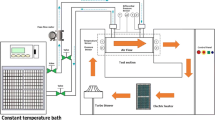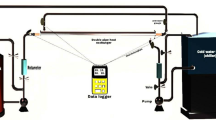Abstract
This research demonstrates the enhancement of a thermosyphon heat exchanger with fins and without fins using Cu-nanofluid as a working fluid. The heat pipe-type thermosyphon used in this study was made of steel. The steel tube had an outside diameter of 20 mm and a thickness of 1.25 mm. The lengths of the evaporator, adiabatic and condenser sections were 20, 10, and 20 cm, respectively. The thermosyphon heat exchanger had 13 tubes with Di-water and Cu-nanofluid as working fluids, and a filling ratio of 50% by total volume. The exchangers were installed with two fin sizes: 0.5 and 1.0 cm. The fins were a 16 piece/pipe. The evaporator section was heated by a heater, while the condenser section was cooled by fresh air. The hot air was controlled at three levels: 60, 70, and 80°C, and the fresh air velocities were adjusted at three levels: 0.5, 1.0, and 1.5 m/s. The test operation focused on the heat transfer rate and thermal effectiveness of the thermosyphon heat exchanger with a fin using Cu-nanofluid as a working fluid. It was found that the maximum value of heat transfer rate and thermal effectiveness occurred when the air velocity was 0.5 m/s, 1 cm of fin, temperature 80°C, and using Cu-nanofluid as the working fluid. It is indicated that the heat transfer rate and thermal effectiveness performance increased when compared with DI-water at all variables.
Similar content being viewed by others
References
Liu, D., Tang, G.F., Zhao, F.Y., and Wang, H.Q., Modeling and Experimental Investigation of Looped Separate Heat Pipe as Waste Heat Recovery Facility, Appl. Therm. Eng., 2006, vol. 26, pp. 2433–2441.
Wang, X., Xu, X., and Choi, S.U.S., Thermal Conductivity of Nanoparticle-Fluid Mixture, J. Thermophys. Heat Transfer, 1999, vol. 13, no. 4, pp. 474–480.
Keblienski, P., Phillpo, S.R., Choi, S.U.S., and Eastman, J.A., Mechanisms of Heat Flow in Suspensions of Nano-Sized Particles (nanofluids), Int. J. HeatMass Transfer, 2002, vol. 45, pp. 855–863.
Eastman, J.A., Phillpot, S.R., Choi, S.U.S., and Keblinski, P., Thermal Transport in Nanofluids, Annu. Rev. Mater. Res., 2004, vol. 34, pp. 219–246.
Jang, S.P. and Choi, S.U.S., Role of Brownian Motion in the Enhanced Thermal Conductivity of Nanofluids, Appl. Phys. Lett., 2004, vol. 84, pp. 4316–4318.
Do, K.H., Ha, H.J., and Jang, S.P., Thermal Resistance of Screen Mesh Wick Heat Pipes Using the Water-Based Al2O3 Nanofluids, Int. J. Heat Mass Transfer, 2010, vol. 53, pp. 5888–5894.
Faghri, A., Chen, M.M., and Morgan, M., Heat Transfer in Two-Phase Closed Conventional and Concentric Annular Thermosyphon, Trans. ASME J. Heat Transfer, 1989, vol. 111, pp. 611–618.
Streltsov, A.I., Theoretical and Experimental Investigation of Optimum Filling for Heat Pipe, Heat Trans. Soviet Res., 1975, vol. 7, pp. 23–27.
Harada, K., Inoue, S., Fujita, J., et al., Heat Transfer Characteristics of Large Heat Pipe, Hitachi Zosen Tech. Rev., 1980, p. 41.
Vafai, K. and Wang, W., Analysis of Flow and Heat Transfer Characteristics of an Asymmetrical Flat Plate Heat Pipe, Int. J. Heat Mass Transfer, 1992, vol. 35, pp. 2087–2099.
Kang, S.W., Wei, W.C., Tsai, S.H., and Yang, S.Y., Experimental Investigation of Silver Nano-Fluid on Heat Pipe Thermal Performance, Appl. Therm. Eng., 2006, vol. 26, pp. 2377–2382.
Yung, X.F., Liu, Z., and Zhao, J., Heat Transfer Performance of a Horizontal Microgrooved Heat Pipe Using CuO Nanofluid, J. Micromech. Micrieng., 2008, vol. 18, p. 035038.
Kang, S., Wei, W., Tai, S., and Huang, C., Experimental Investigation of Nanofluid on Sintered Heat Pipe Thermal Performance, Appl. Therm. Eng., 2009, vol. 29, pp. 973–979.
Parametthanuwat, T., Rittidech, S., and Pattiya, A., A Correlation to Predict Heat-Transfer Rates of a Two-Phases Closed Thermosyphon (TPCT) Using Silver Nanofluid at Normal Operating Conditions, Int. J. Heat Mass Transfer, 2010, vol. 53, pp. 4960–4965.
Hyung, K. and Pil, S., Effect of Nanofluids on the Thermal Performance of a Flat Micro Heat Pipe with a Rectangular Grooved Wick, Int. J. Heat Mass Transfer, 2010, vol. 53, pp. 2183–2191.
Liu, Z.H., Yang, X.F., and Guo, G.L., Effect of Nanoparticles in Nanofluids on Thermal Performance in a Miniature Thermosyphon, J. Appl. Phys., 2007, vol. 102, pp. 2953–2960.
Hundu, B. and Das, P.K., Performance Analysis and Optimization of Elliptic Fins Circumscribing a Circular Tube, Int. J. Heat Mass Transfer, 2007, vol. 50, pp. 173–180.
Anon, Heat Pipe-Performance of Two-Phase Closed Thermosyphons, Data-item no. 81038, Engineering Sciences Data Unit, London, 1981.
Bezrodnyi, M.K. and Alekseenko, D.B., Investigation of the Critical Region of Heat and Mass Transfer in Low-Temperature Wickless Heat Pipe, High Temp., 1977, vol. 15, pp. 309–313.
Anon, Heat Pipe-General Information on Their Use, Operation and Design, Data-item no. 80013, Engineering Sciences Data Unit, London, 1980.
El-Genk, M.S. and Saber, H.H., Determination of Operation Envelopes for Closed/Two-Phase Thermosyphon, Int. J Heat Mass Transfer, 1999, vol. 42, pp. 889–903.
Incropera, F.P. and DeWitt, D.P., Fundamentals of Heat and Mass Transfer School of Mechanical Engineering Purdue University, 4th ed., 1996.
Author information
Authors and Affiliations
Corresponding author
Rights and permissions
About this article
Cite this article
Meena, P., Tammasaeng, P., Kanphirom, J. et al. Enhancement of the performance heat transfer of a thermosyphon with fin and without fin heat exchangers using Cu-nanofluid as working fluids. J. Engin. Thermophys. 23, 331–340 (2014). https://doi.org/10.1134/S1810232814040110
Received:
Published:
Issue Date:
DOI: https://doi.org/10.1134/S1810232814040110




